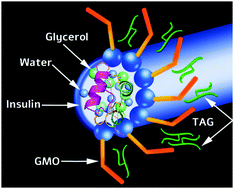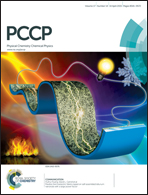The dielectric study of insulin-loaded reverse hexagonal (HII) liquid crystals
Abstract
The dielectric behavior of the insulin-loaded HII mesophase (containing GMO–TAG–water–glycerol–insulin) was studied using two empty reference systems (GMO–TAG–water and GMO–TAG–water–glycerol) at a frequency range of 10−2–106 Hz, and a temperature range of 290–333 K. Three clearly defined relaxation processes were observed and assigned to the reorientation of GMO polar heads, the tangential movement of counterions at the interface, and the movements of TAGs through the lipid tail. Upon addition of glycerol, a heterogeneous inner structure was formed within the HII cylinders: the water–glycerol core surrounded by a water rigid layer. Upon heating, two critical points were detected referring to the dehydration of the GMO heads (at 304 K, similar to the water-filled HII system) and to energetic modifications (at 316 K), resulting in breaking of the water layer allowing on-demand controlled release. Insulin incorporation combined the features of both reference HII systems. Yet, unlike the empty HII systems, insulin perturbed the GMO–water interface while decreasing the movement of the GMO headgroup, and reducing T0 (296 K). No interactions were formed between the dipole of each counterion at the interface region and the matrix (the GMO), fitting the Debye process. Dynamic behavior was observed, pointing to mobility between the hexagonal rods themselves, enabling controlled release from the HII carrier.


 Please wait while we load your content...
Please wait while we load your content...